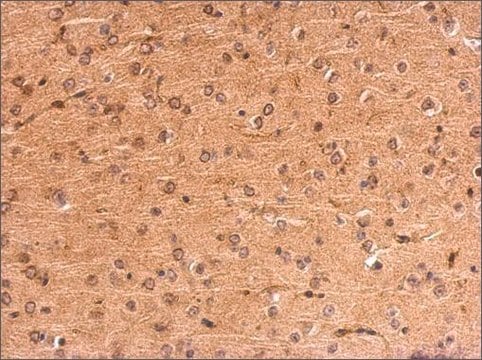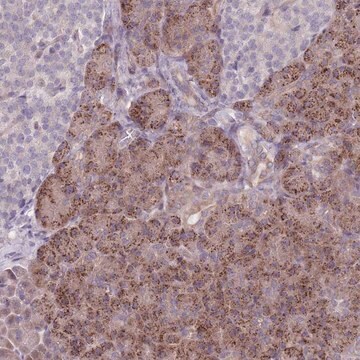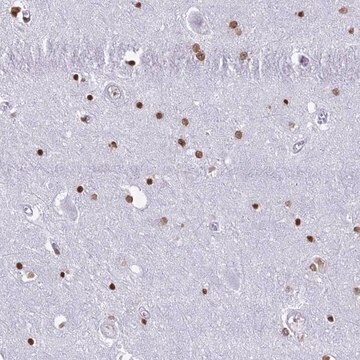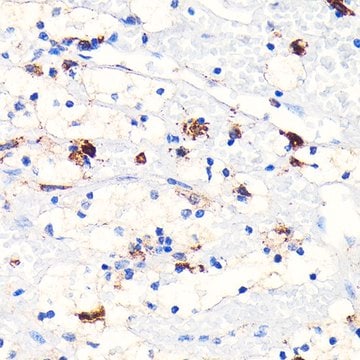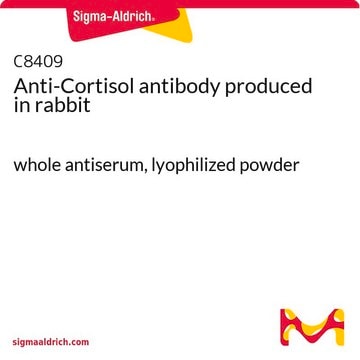推荐产品
生物源
rabbit
品質等級
共軛
unconjugated
抗體表格
affinity isolated antibody
抗體產品種類
primary antibodies
無性繁殖
polyclonal
形狀
buffered aqueous solution
物種活性
human
濃度
1 mg/mL
技術
immunohistochemistry (formalin-fixed, paraffin-embedded sections): 2.5-7 μg/mL using human tissue
UniProt登錄號
運輸包裝
dry ice
儲存溫度
−20°C
基因資訊
human ... MC1R(4157)
mouse ... Mc1r(17199)
一般說明
Anti-Melanocortin 1 Receptor is produced in rabbit using as immunogen a synthetic peptide conjugated to KLH. The peptide corresponds to the third cytoplasmic loop of human Melanocortin 1 Receptor. The antibody is affinity-purified using the immunizing peptide immobilized on agarose.
Anti-Melanocortin 1 Receptor specifically recognizes human melanocortin 1 receptor by immunohistochemistry in formalin-fixed, paraffin-embedded tissues. Not tested for other uses. The immunizing peptide has 88% homology with the mouse gene. Other species reactivity has not been confirmed. Expression of melanocortin 1 receptor has been reported primarily in adrenal, skin, and testis. ESTs have been isolated from breast, placenta, and testis libraries.
Anti-Melanocortin 1 Receptor specifically recognizes human melanocortin 1 receptor by immunohistochemistry in formalin-fixed, paraffin-embedded tissues. Not tested for other uses. The immunizing peptide has 88% homology with the mouse gene. Other species reactivity has not been confirmed. Expression of melanocortin 1 receptor has been reported primarily in adrenal, skin, and testis. ESTs have been isolated from breast, placenta, and testis libraries.
免疫原
synthetic peptide corresponding to the third cytoplasmic loop of human melanocortin 1 receptor. The immunizing peptide has 88% homology with the mouse gene.
應用
Anti-Melanocortin 1 Receptor antibody produced in rabbit was used in immunoblotting for chondrocyte protein extracts at a dilution of 1:2000.
生化/生理作用
Melanocortin 1 receptor (MC1R) is a G-protein coupled receptor that regulates the proliferation and differentiation of melanocytes. The melanocortin hormones activate MC1R that in turn triggers ERK1/2 pathway that promotes the synthesis of eumelanin pigments. Overexpression of MC1R is reported in a majority of human melanomas and acts as a marker in these tumor.
外觀
Solution in phosphate buffered saline containing ≤0.1 % sodium azide.
免責聲明
Unless otherwise stated in our catalog or other company documentation accompanying the product(s), our products are intended for research use only and are not to be used for any other purpose, which includes but is not limited to, unauthorized commercial uses, in vitro diagnostic uses, ex vivo or in vivo therapeutic uses or any type of consumption or application to humans or animals.
Not finding the right product?
Try our 产品选型工具.
儲存類別代碼
10 - Combustible liquids
水污染物質分類(WGK)
nwg
閃點(°F)
Not applicable
閃點(°C)
Not applicable
Marta Abrisqueta et al.
Journal of cell science, 126(Pt 16), 3724-3737 (2013-06-12)
The melanocortin 1 receptor (MC1R) is a G-protein-coupled receptor (GPCR) crucial for the regulation of melanocyte proliferation and differentiation. MC1R activation by melanocortin hormones triggers the cAMP pathway and stimulates the extracellular-signal-regulated protein kinases ERK1 and ERK2 to promote synthesis
Judit Váradi et al.
PloS one, 12(1), e0170537-e0170537 (2017-01-20)
Alpha-melanocyte-stimulating hormone (α-MSH) is a potent anti-inflammatory peptide with cytoprotective effect in various tissues. The present investigation demonstrates the ability of α-MSH to interact with intestinal epithelial cell monolayers and mitigate inflammatory processes of the epithelial barrier. The protective effect
A A Rosenkranz et al.
Biochemistry. Biokhimiia, 78(11), 1228-1237 (2014-01-28)
The conventional chemotherapeutic treatment of malignant melanoma still remains poorly efficient in most cases. Thus the use of specific features of these tumors for development of new therapeutic modalities is highly needed. Melanocortin 1 receptor (MC1R) overexpression on the cell
Magdalena K Kaneva et al.
British journal of pharmacology, 167(1), 67-79 (2012-04-05)
Melanocortin MC(1) and MC(3 ) receptors, mediate the anti-inflammatory effects of melanocortin peptides. Targeting these receptors could therefore lead to development of novel anti-inflammatory therapeutic agents. We investigated the expression of MC(1) and MC(3) receptors on chondrocytes
我们的科学家团队拥有各种研究领域经验,包括生命科学、材料科学、化学合成、色谱、分析及许多其他领域.
联系技术服务部门

